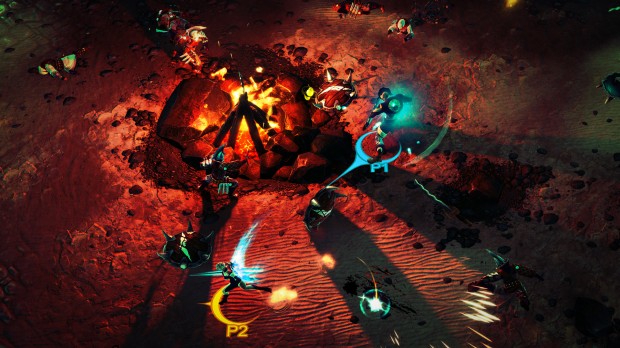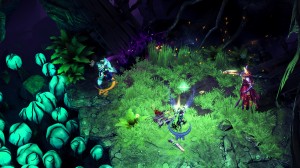Sacred 3 Review (360)
- Updated: 1st Aug, 2014

Having played Sacred 1, 2 and Sacred Citadel I was pretty interested to see where Deep Silver and Keen Games have taken the series with Sacred 3. They’ve combined hack ‘n’ slash elements with RPG elements, the pacing of combat in this instalment is much faster than the previous games.
They’ve moved from a serious story to a more light hearted one, with “humour” being a major part of dialogue. The dialogue is pretty appalling and you can’t really do anything about it. You have a sidekick who can talk to you telepathically, but the problem is that she constantly shouting down your ear with jokes and instructions, all the damn time.
As well as your little sidekick you unlock spirits that empower your weapons, all of which offer buffs and talk to you. I ended up with a dragon who is basically Mushu from Mulan. These can be upgraded with “shards” , but throughout the game I only got one shard right up until the second to the last main mission, where I got seven. The game never actually explains how to obtain them; it seems to be random.
Each character has a different skill tree and special abilities called “combat arts”, which are more or less magic powers. As you level up your armour, combat arts and weapons become stronger and offer different effects.
There are 5 classes, including Kython the Malakhim Assassin – who was made a pre order bonus in May, here’s a rundown of each:
- Marak The Safiri Warrior – Focus on damage
- Claire The Seraphim Paladin – Good balance of defence and damage balance
- Vajra The Khukuri Archer – Long range, good speed
- Alithea The Ancarian Lancer – Medium range, focus on critical hits
- Kython The Malakhim Assassin – Focus on speed and critical hits
What is pretty interesting is that you can unlock different weapons, so you can have different effects, Malakhim starts off with a weapon that only offers simple buffs such as damage buffs, but can unlock a weapon that causes small explosions.
The game is split up into missions, rather than just a huge free roam map. But that of course means, no fancy mounts like we had in Sacred 2. There are two kinds of missions: Rank 1 and Rank 2.
Rank 1 missions, also referred to as main missions, are the story missions. These range from destroying strongholds to finding artefacts that help you in the war against the Ashen Empire. There are 15 of these missions each set in a different landscape. But they suffer from repetitiveness, they all follow a bit of a formula: avoid falling rocks, spin wheel – six times! The same wheel, six times. Kill the boss, – this formula is used in a bunch of levels, sometimes it’s mixed up a little to avoid falling shit from the sky – destroy miniature tower, kill the boss. And on one occasion spinning wheels was the boss fight.
 Rank 2 missions are small side missions that allow you to unlock special items; health potion (which you can use to revive yourself), healing totems, energy totems, protection aura – all of which aid your team too – magic sentry and smart bombs. There are a lot more of these missions than the main missions, but they typically last 5-10 minutes. You get two versions: one version is a wave match where five waves of enemies come at you; the other is a small map where you battle to a giant chest at the end.
Rank 2 missions are small side missions that allow you to unlock special items; health potion (which you can use to revive yourself), healing totems, energy totems, protection aura – all of which aid your team too – magic sentry and smart bombs. There are a lot more of these missions than the main missions, but they typically last 5-10 minutes. You get two versions: one version is a wave match where five waves of enemies come at you; the other is a small map where you battle to a giant chest at the end.
I played through the game on Legendary which is basically the hard mode. After playing through once, you can play Deity difficulty. Legendary difficulty served its purpose really well; it was difficult but not chew-your-controller difficult.
Sacred 3 is very geared to competitive co-op play. As you upgrade your armour and combat arts you’ll find that your buffs don’t just help you but also your team. They may get a damage bonus or protection bonus. At the end of each level players are ranked on their abilities to kill, revive and earn extra points for performing “technique kills”, though how you actually do these is never explained.
I played through the whole game by myself and then played some co-op. It’s pretty fun in co-op, but it’s also pretty unambitious. The heavy emphasis on co-op means that singleplayer the game suddenly feels like the developers neglect you – you don’t get an AI team to help you out. The biggest evidence of this would be the “Team Prayer” a special move that does more damage as a team. In single player there’s next to no damage inflicted, meaning that you’re better off just hitting the enemy in the face with your standard attack instead.
Sacred 3 doesn’t have anything that we haven’t seen in a different game. There’s no unique aspect in there. They don’t really think about mixing up the game; it would have been great with some bonus missions at the end, maybe an endless horde mode? And some customization would be great.
It’s pretty fun all around, maintaining decent gameplay, but never pushes the boat out. They never seem to aim for anything new or exciting. This is especially apparent in the level design, where they’ve clearly recycled the levels over and over.


Follow Us!